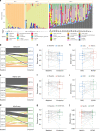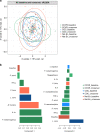Hormonal contraception alters vaginal microbiota and cytokines in South African adolescents in a randomized trial
- PMID: 33149114
- PMCID: PMC7643181
- DOI: 10.1038/s41467-020-19382-9
Hormonal contraception alters vaginal microbiota and cytokines in South African adolescents in a randomized trial
Abstract
Young women in sub-Saharan Africa are disproportionally affected by HIV infection and unintended pregnancies. However, hormonal contraceptive (HC) use may influence HIV risk through changes in genital tract microbiota and inflammatory cytokines. To investigate this, 130 HIV negative adolescent females aged 15-19 years were enrolled into a substudy of UChoose, an open-label randomized crossover study (NCT02404038), comparing acceptability and contraceptive product preference as a proxy for HIV prevention delivery methods. Participants were randomized to injectable norethisterone enanthate (Net-En), combined oral contraceptives (COC) or etonorgesterol/ethinyl estradiol combined contraceptive vaginal ring (CCVR) for 16 weeks, then crossed over to another HC for 16 weeks. Cervicovaginal samples were collected at baseline, crossover and exit for characterization of the microbiota and measurement of cytokine levels; primary endpoints were cervical T cell activation, vaginal microbial diversity and cytokine concentrations. Adolescents randomized to COCs had lower vaginal microbial diversity and relative abundance of HIV risk-associated taxa compared to Net-En or CCVR. Cervicovaginal inflammatory cytokine concentrations were significantly higher in adolescents randomized to CCVR compared to COC and Net-En. This suggests that COC use may induce an optimal vaginal ecosystem by decreasing bacterial diversity and inflammatory taxa, while CCVR use is associated with genital inflammation.
Conflict of interest statement
The authors declare no competing interests.
Figures




References
-
- UNAIDS. Ending AIDS: Progress Towards 90-90-90 Targets (2017).

